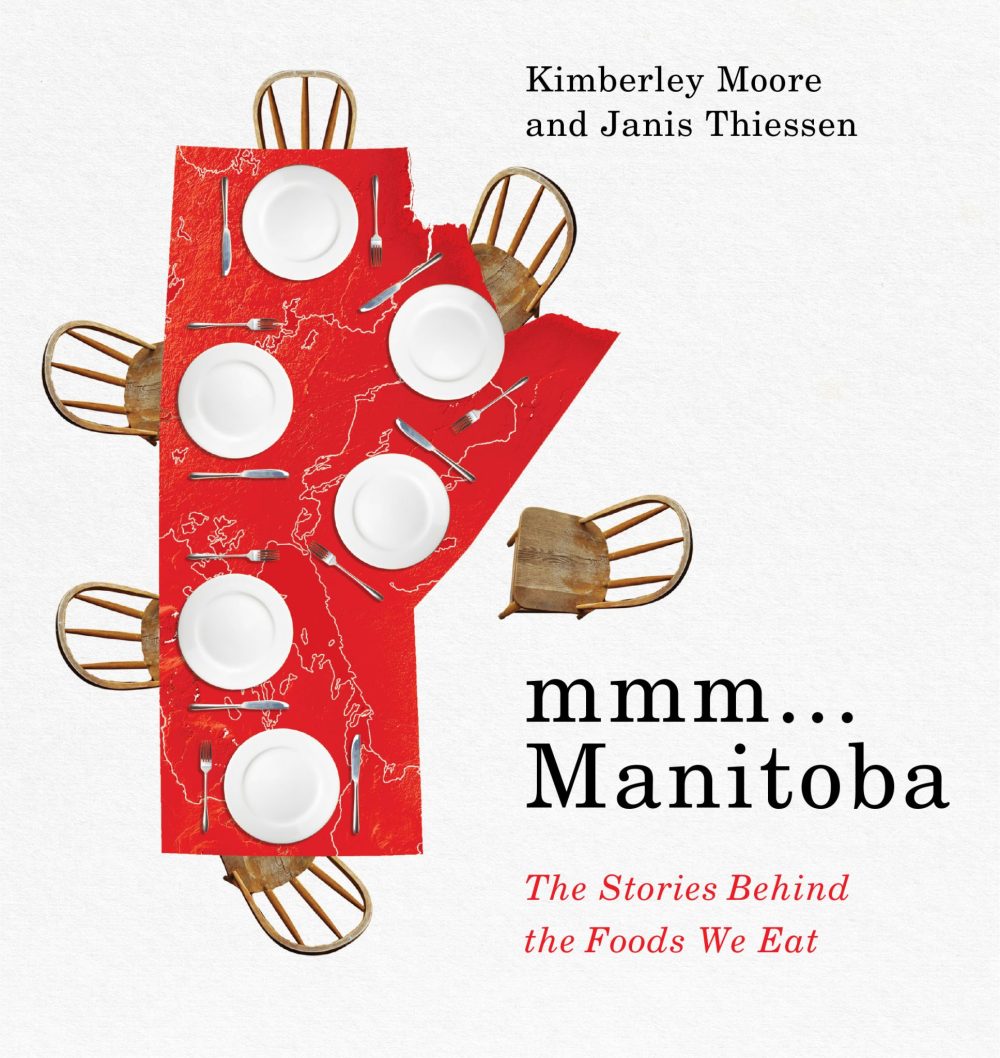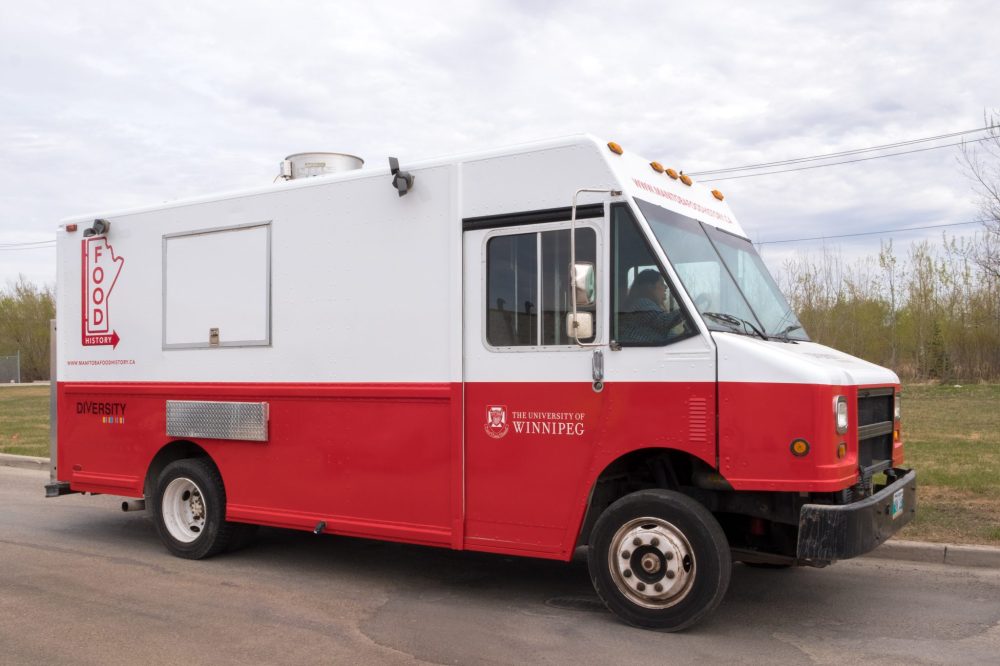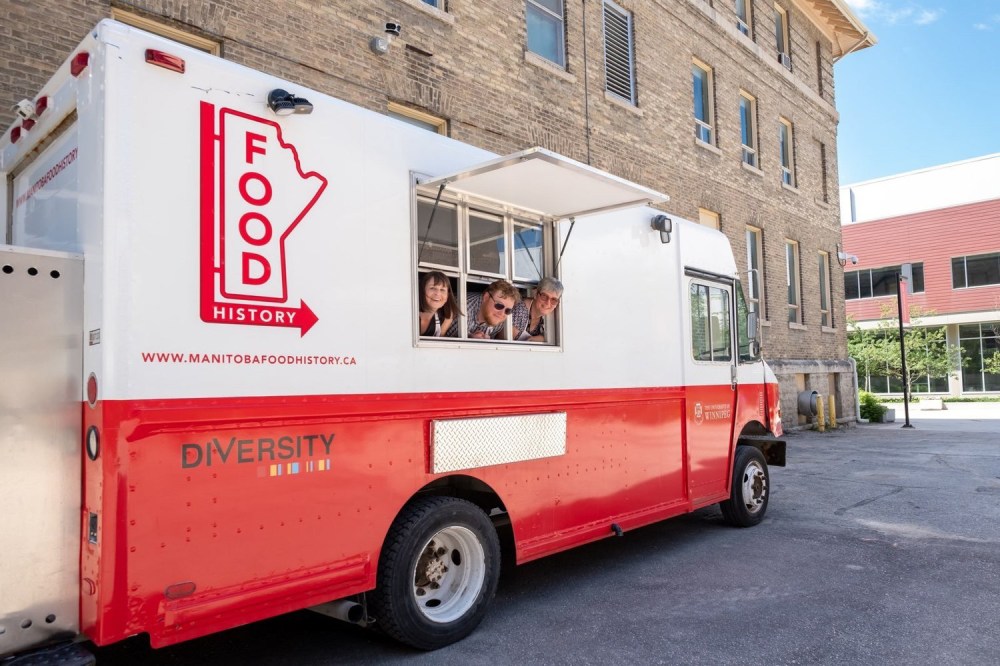History of Manitoba one food truck recipe at a time
Advertisement
Hey there, time traveller!
This article was published 22/04/2024 (440 days ago), so information in it may no longer be current.
What memories are recalled when we think of or cook Grandma’s perogies, the family’s chicken adobo, or Kjielkje and schmauntfat? These dishes are the foods that built the Southeast. Now in a new book, Mmm…Manitoba: The Stories Behind the Foods We Eat, two historians in a food truck take the reader through the food history of Manitoba, including the Southeast.
Co-authors Janis Thiessen and Kimberley Moore conducted 70 interviews with Manitobans around the province in their Manitoba Food History Truck as part of the Manitoba Food History Project, an ongoing history project at the University of Winnipeg.
“I had written a book called Snacks and discovered food history was a thing and we all got to get to know each other – Kenton (Davies), Kim, and I – here at the University of Winnipeg and we thought, ‘You know what might be fun and interesting? Interviewing people about the food they think is memorable.’ And I think as a joke someone suggested we get a food truck and we thought, ‘Yeah! we can make that happen, and we did,” said Thiessen.

Mmm…Manitoba takes readers through the cities and towns of Winnipeg, Churchill, Steinbach, Carman, Altona, and Dauphin to name a few. Seventeen people cooked on the food truck. Some of the questions asked during the tour were: What are your earliest memories of eating the recipe you are preparing for us on the Food History Truck? And, in what ways is the recipe you are preparing for us on the Food History Truck distinctly Manitoban? To what extent does that matter to you?
The seven-chapter book, whose research took five years, included interviews from vendors at Steinbach’s Summer in the City Festival and the Ontong family about Filipino barbeque, the diaspora, and their chicken adobo recipe.
“It’s really fascinating how the place has changed. How Steinbach is more diverse,” said Thiessen. “We took the truck to Altona for the Sunflower Festival, and we did an interview in Carman as well. People have, I think, sometimes the wrong sense of what Southern Manitoba is like and they see it as a monolith, but there’s tremendous diversity. There’s a vibrant Filipino community there.”
Steinbachers Kris and Peegy Ontong made their family’s chicken adobo, a Filipino dish where chicken is cooked in soya sauce, vinegar, garlic, and other herbs and spices.
Considered the unofficial national dish of the Philippines, according to Kris, the dish is flexible in its difficulty.
“This is something that we thought would appeal to the tastebuds of Janis and Kimberley and we weren’t disappointed. They really liked it!” he said.

There are about 2,220 Filipinos in the Southeast, according to the South EastMan Filipino Association. Manitoba retained its position with the highest proportion of Filipinos on a per capita basis, with Filipinos comprising 6.78 percent of the provincial population, according to the Philippine Embassy in Ottawa.
Kris said Filipinos living in the Southeast have changed their food by the ingredients that they use because they can’t find the same ingredients that they have in the Philippines. The chicken is different, so is the garlic, and cooking oil.
Conversely, Filipinos have changed the way people in the Southeast eat by opening up the cuisine to the region, making some dishes popular, such as lumpia spring rolls, which have in turn also changed from traditional pork to include beef and chicken to accommodate Western tastebuds.
“There’s some cultural transfusion that’s happening because of the cuisine,” said Kris. “It brings people together and it inspires people to be creative.”
Kris said he and his wife signed up for the Manitoba History Project because they saw it as an opportunity to have Filipino representation.
“It’s a documentary study. It’s going to be a part of our province’s history because it’s food history. That also takes note that there are different cultures now in Manitoba now that’s changing the fabric of local cuisine and we we’re really proud to showcase our unofficial national dish. It’s for posterity, basically, and we want the Filipino culture to be represented in Manitoba’s food history.”

“I just wanted to say that it’s one of the ethnic cuisines that brings cultural barriers down…when people get to taste the cuisine from a different part of the world, from a different culture, what I notice is that it becomes a great conversation starter and it removes that cultural barrier between people,” Kris noted.
Thiessen said she and Moore had fun making the book and that one of the joys of oral history is that “you need people whose background and experiences are not yours and they can tell you in their own words and educate you and it’s been just a delight.”
To make the scholarly work accessible to a broader audience, Thiessen and Moore built a website, created 18 podcast episodes, had nine story maps, and established a social media presence.
“We wanted it to be for everybody. That was the hope, that a wide variety of people could find something to connect with,” said Moore.
One of the arguments made in the book is that food is an entry point to every other aspect of not only the province but of North America as well.

“When you learn about food, you learn about the history of immigration, the history of foreign policy, the history of racism, the history of sexism, the history of government regulation. I think you would be hard pressed to find an aspect of history that food does not impinge upon an entry way into these topics. That’s one of the reasons we wanted to do this. There’s a limited audience on food regulation, but you hide it in a chapter about perogy ladies and who doesn’t want to read that?” said Thiessen.
One story that stands out for Thiessen in the book is the duo’s interview with University of Winnipeg head safety officer Kevin Smith. He was showing them how to make puff wheat bars and during the recipe the conversation turned to gender roles.
“It ended up being a conversation that we couldn’t have predicted because he was telling us about his experience growing up in small town Manitoba, raising a family. And then it became this discussion about gender expectations and gender identity and how he is viewed as a stay at home raiser of children and purchaser of groceries. How do you reconcile that with the expectations of your community at a certain time and at a certain place have of you as a man?”
When asked if the sharing of stories and culture is easier when done through food, Moore said she wasn’t sure, but it was certainly more delicious!
“My background is in oral history and it’s something that I love deeply because stories are how we communicate with each other without exception. When you cook together and you do share stories about food there is that benefit of disguising heavier topics. There’s less pressure, it’s more relaxed and it really does as – someone who is interviewing as a historian – it does emphasize that you are there to learn because you have no idea how their recipe works so you become the student there.”
One take away from the book that Thiessen and Moore would like readers to have is there is so much to learn about the history of Manitoba and that it is a diverse province.

“I think sometimes we’re always defending ourselves as this worthwhile province in the national context, and we’re not always the shiniest province, but I think that the takeaway is that Manitoba is a pretty interesting place and certainly in a sense of culture, it’s not less than. The diversity here and the willingness where we all adopt each other’s foodways it was surprising to find the extent in that,” said Moore.
Mmm…Manitoba can be purchased on the University of Manitoba Press’ website uofmpress.ca/books/mmm-manitoba.
